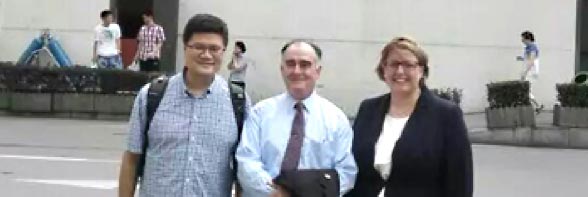
Italian Association for the Rehabilitation of Respiratory Care Marks 26 Years of Improving Patient Care
June 25, 2015
2015 Tongji Mechanical Ventilation Forum Builds on Tradition
September 1, 2015By Patrick J Dunne, MEd, RRT, FAARC, ICRC Governor, USA
In January of this year, a study investigating the effect of oscillating positive expiratory pressure (OPEP) in the treatment and management of postoperative pulmonary complications appeared in the Australian Journal of Physiotherapy.1 The primary authors were Dr. Xianh-yu Zhang, ICRC Governor for China, and respiratory therapist Qixing Wang (“Carol”), a past AARC International Fellow. In this important and timely multi-center study, the researchers concluded that OPEP therapy, provided over a 5-minute period, three times per day, for the first 5 postoperative days, resulted in fewer cases of fever and shorter hospital stays for patients undergoing thoracic or upper abdominal surgery. Both the control and experimental groups received standard postoperative medical management and early mobilization, with only the experimental group receiving the OPEP intervention. All OPEP therapy sessions were administered and supervised by either a physician or respiratory therapist.
While not all prior outcomes reached statistical significance, it is important to note the significant reduction in the incidence of postoperative fever and length of stay in the experimental group. The importance (and timeliness) of these findings is underscored by the recent publication of another excellent article by Taylor and colleagues, in which they estimated postoperative pulmonary complications might cost the US healthcare system upwards of $3.4 billion annually.2
I, for one, was astonished at the magnitude of Taylor’s cost estimate, not to mention concerned for the pain and suffering unintentionally inflicted on the thousands of patients who develop a serious postoperative pulmonary complication. However, I soon came to realize that this patient population would derive tremendous benefit were a program described by Zhang and Wang made readily available, on a routine basis, to all high-risk surgical patients. As with most hospital-acquired conditions, the majority of postoperative pulmonary complications are largely preventable, or at the very least, less serious when identified and treated sooner rather than later during the postoperative recovery period.
In these times where emphasis is increasingly being placed on improving patient safety while achieving quality outcomes of care, respiratory therapists have yet another opportunity to demonstrate the value contribution we can make to patient care, in this case to the millions of patients undergoing thoracic or upper abdominal surgery. Thanks to Dr. Zhang and colleagues for showing exactly how one such intervention can work.
References:
1. Zhang Xiang-yu, Wang Qixing, et al. The use of a modified, oscillating positive expiratory pressure device reduced fever and length of stay in patients after thoracic and upper abdominal surgery: a randomized trial. Journal of Physiotherapy. Vol. 61; No. 1; January 2015. Available for free download via Open Access at: http://dx.doi.org/10.1016/j.jphys.2014.11.013
2. Taylor A, DeBoard Z, et al. Prevention of postoperative pulmonary complications. Surg Clin N Am. Vol. 95; April 2015.


